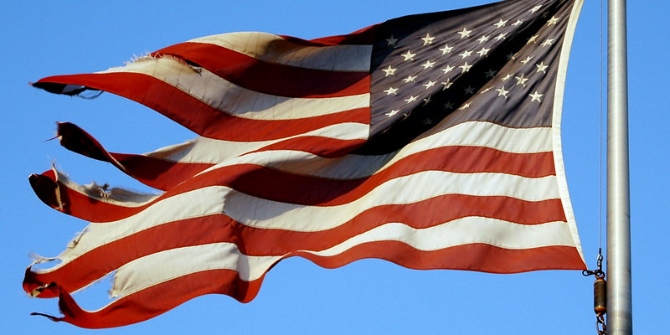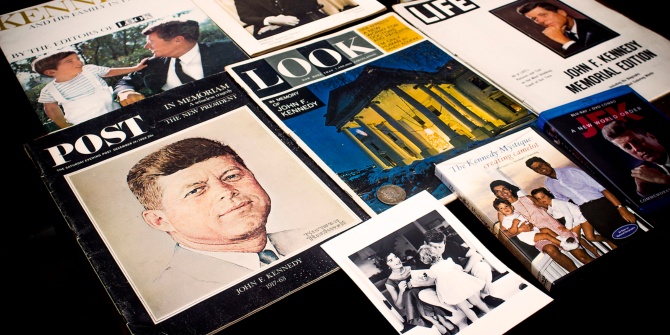Local political parties are an important part of US politics, as they are often the best placed to mobilize voters and to recruit and support candidates. But how do these groups interact with voters online? In new research Lee Hannah and co-authors looked at the online presence of local parties across the US’ more than 3,100 counties. They found that while fewer than half of county parties had websites, more than two thirds had a presence on Facebook, and that this percentage was even higher for parties based in more urban and more electorally competitive counties.
Especially in election years like this one, local political parties play a critical role in mobilizing voters, recruiting candidates for lower offices, and providing the infrastructure needed for candidates for statewide and federal offices to succeed. But how easy is it for the average voter to get connected to their local party at a time when in-person connections are increasingly seen as risky because of the COVID-19 pandemic? To find out, we searched for the online presence of the local parties.
How we surveyed the online presence of the parties
During the summer of 2020, our team of seven researchers looked up the Democratic and Republican parties for each of the 3,141 counties in the United States. In our initial data collection, we sought to collect information on the county party in each state via Google search to find key details like website URLs and email details. If a county webpage was not available on the first page of Google results, we would follow up by searching for links to social media (Facebook, Twitter, or Instagram) which we would then record (also checking these sites for party webpage details which we might have missed). If we were still empty handed after our Google search, then we would conduct the same search, but instead focus on social media terms, and failing positive results for those, we would look at information on the state party website.
Our searches left us with three general impressions:
-
Fewer than half of all major county parties have established websites.
Some of the limited research on the topic shows that state Democratic and Republican parties vary significantly in their technical capabilities. At the county level, we found that only 53 percent of Democratic parties and 42 percent of Republican parties have a website. Not all of these websites were very well updated and it was obvious that in some states, the state parties had at one time set up websites, only to let them expire and disappear or become years out of date.
Figure 1 – Online presence and activity of local parties
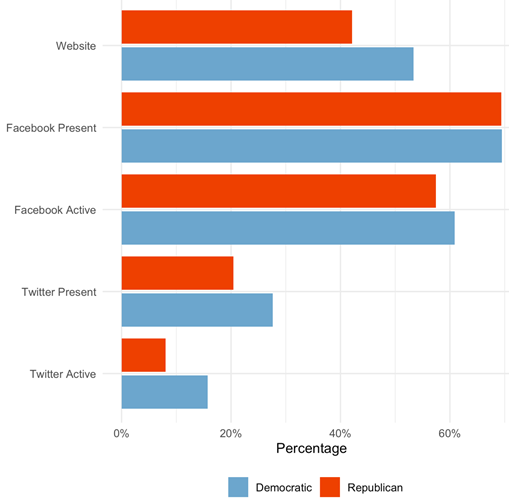
-
The best way to connect with the parties on social media is via Facebook, followed by Twitter.
From our sample, 70 percent of Democratic parties and 69 percent of Republican parties have a page or group on Facebook. Facebook is also the most widely used platform by Americans; in 2019, nearly 70 percent of American adults reported having a Facebook account.
The activity on these pages and groups ranged, as again some were very out of date. 61 percent of Democratic and 57 percent of Republican pages or groups have been active since the beginning of the party conventions. This data is from CrowdTangle, a public insights tool owned and operated by Facebook. You can view what the parties are sharing through the dashboard we have created here.
We found that only 24 percent of the county parties had a presence on Twitter; a similar percentage of Americans (22 percent) use the platform. We find that Democratic parties (28 percent) are more likely to have a Twitter profile than Republican parties (20 percent). This difference may reflect the parties’ catering to their bases. A 2019 Pew analysis found that an overwhelming share of tweets come from users who strongly disapprove of President Trump. Again, considering only active accounts this number shrinks to 16 percent and 8 percent for Democratic and Republican parties respectively.
Local parties were even less likely to use Instagram, with only 10 percent of Democrats and 4 percent of Republicans on the platform. Instagram is among the least popular social media platforms for those over 50, but is becoming increasingly popular with those between the ages of 18 and 24.
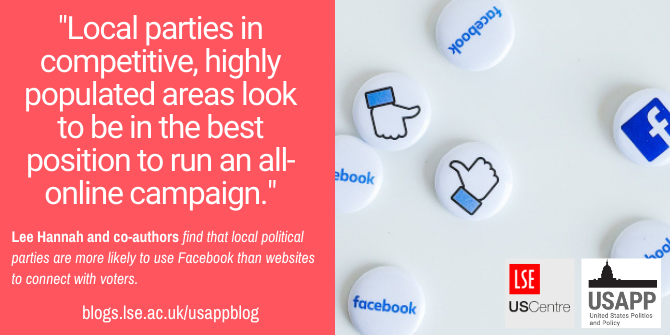
Photo by NeONBRAND on Unsplash
-
County population and electoral competitiveness explain some of the variation.
We found major disparities between the county parties in densely populated areas and those in rural areas. We used classifications related to the county population to explore the differences in county parties in urban, suburban, and rural areas. Among Democrats in urban areas 72 percent have active Facebook accounts compared to only 29 percent in rural areas, for Republicans the rate goes from 67 percent to 16 percent. The same patterns are apparent when comparing across social media platforms.
Figure 2 – Online activity of local parties by county type

The Electoral College makes presidential candidates target a number of competitive, or battleground, states. Research shows that parties are more likely to contact voters living in battleground states. County parties in competitive states were more likely to have a strong web presence. In competitive states, 72 percent of Republican parties had active Facebook accounts compared to 52 percent in non-competitive states, for Democrats this was 78 percent and 54 percent. Our finding confirms recent research showing a relationship between local party activity and electoral performance.
Figure 3 – Online activity of local parties by state competitiveness
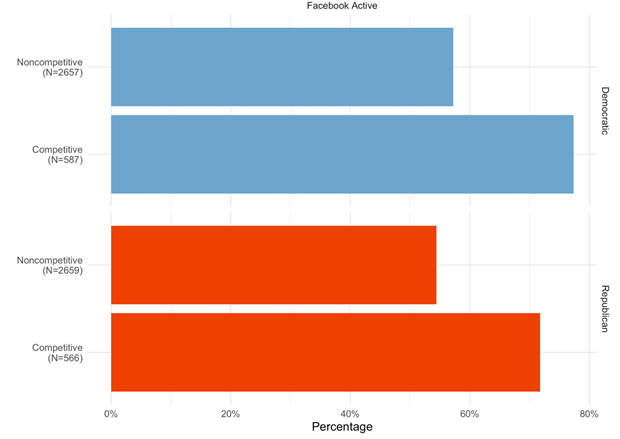
In the midst of the coronavirus pandemic, the Democratic Party in particular has foregone traditional political rallies and voter mobilization in favor of online activities. During the 2020 election, online organization of local political parties may prove more important than ever. Although many local parties are ready to adapt to these constraints, this is far from universal. Local parties in competitive, highly populated areas look to be in the best position to run an all-online campaign.
Please read our comments policy before commenting.
This article gives the views of the author, and not the position of USAPP– American Politics and Policy, or of the London School of Economics.
Shortened URL for this post: https://bit.ly/31b2IJo
About the authors
 Lee Hannah – Wright State University
Lee Hannah – Wright State University
Lee Hannah (@LeeHannahWSU) is an Associate Professor of Political Science in the School of Public and International Affairs at Wright State University. His research focuses on state politics, policy diffusion, elite behavior, and cannabis policy.

Kevin Reuning – Miami University
Kevin Reuning (@KevinReuning) is an assistant professor of political science at Miami University. His research and teaching focus on political parties and social movements in the United States as well as latent variable modeling and social network analysis.
 Anne Whitesell – Miami University
Anne Whitesell – Miami University
Anne Whitesell (@annewhitesell) is an assistant professor of political science in the Department of Political Science at Miami University. Her research lies at the intersection of representation and public policy, with a focus on how marginalized populations are represented in the American political system.
 Tim Binnig – Miami University
Tim Binnig – Miami University
Tim Binnig is a Junior at Miami University studying Political Science and Psychology.
 Emily Cain – Miami University
Emily Cain – Miami University
Emily Cain is a BA/MA candidate at Miami University.
 Austin Lucous – Wright State University
Austin Lucous – Wright State University
Austin Lucous (@ALucous) is an undergraduate senior studying Political Science in the School of Public and International Affairs at Wright State University in Dayton, Ohio. Austin focuses his studies on Ohio and American politics.
 Whitney Tyler – Wright State University
Whitney Tyler – Wright State University
Whitney Tyler is senior undergraduate student studying Political Science in the School of Public and International Affairs at Wright State University. Her academic focus is American Politics with an emphasis on campaigns and elections.



